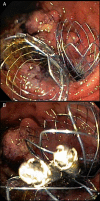A "Kissing-Stents" Technique in the Management of Afferent Limb Syndrome With Concomitant Efferent Limb Obstruction in a Patient With Gastric Cancer and Billroth II Anatomy
- PMID: 32309485
- PMCID: PMC7145159
- DOI: 10.14309/crj.0000000000000266
A "Kissing-Stents" Technique in the Management of Afferent Limb Syndrome With Concomitant Efferent Limb Obstruction in a Patient With Gastric Cancer and Billroth II Anatomy
Abstract
The "kissing-stents" technique has been used in endovascular interventions for the management of aortic and arterial stenosis at bifurcation sites. However, to our knowledge, the use of this technique to prevent stent migration in endoscopy has not been described to date. We present a 65-year-old man with metastatic gastric adenocarcinoma status post-Billroth II gastrojejunostomy complicated by simultaneous afferent and efferent limb syndrome with gastric outlet obstruction and biliary dilatation. Two uncovered metal stents were used to relieve the afferent and efferent loop obstructions. These 2 stents were anchored together in a "kissing-stents" technique and using a clip to prevent migration. The patient was able to resume oral intake, and his liver function tests improved. This intervention should be considered in other cases of advanced malignancies causing obstructions for curative or palliative intent.
© 2020 The Author(s). Published by Wolters Kluwer Health, Inc. on behalf of The American College of Gastroenterology.
Figures





References
-
- Hashimoto S, Sendo K, Ido A. Endoscopic double stenting for afferent and efferent loop stenosis in a patient with recurrent gastric carcinoma after Billroth II reconstruction. Dig Endosc. 2016;28(4):485. - PubMed
Publication types
LinkOut - more resources
Full Text Sources

